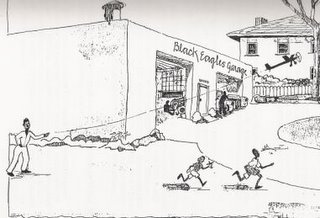Daddy's Garage - Part 1 The Innocent Years (Cont), by Wes Brewton

Daddy's Garage was large enough for us to have our own play area with a large pot-bellied stove to keep us warm during the winter. It was here that I first remember Bubba building and flying a model airplane. Unlike pylon racers, these models were boxey in configuration with long slim wings. To power the model, Bubba would use thinly cut strips of discarded inner tubes from daddy's garage.
After winding its propeller, he would launch the model into the wind and it would fly like a bird. The first time I saw this happen, I thought Bubba had some magical powers and would chase the plane until it glided back to the ground.
Cookie and I would tie two sticks together, like a cross, and throw these contraptions into the air hoping ours would fly, just to see them fall like rocks to the ground.
Sometimes Bubba's plane would fly into our large sycamore tree and crash. Like a doctor, Bubba would mend his model with balsa wood and glue, cover the broken part with tissue, and the plane would be flying again just as gracefully as before.
Daddy's garage was well equipped with tools of all sorts and so was our area. As I remember, we always had a jig saw, circular table saw, drill press, wood turning lathe, hand tools, and work benches.
As I look back into our past from the vantage point of today, I can say with certainty that we were poor, comfortable, but poor. Poor, but not humble, but there were others much poorer than we were.
I remember a poor white family on St. Ferdinand Street who lived in a "shotgun house," i.e., you could look straight through the house and into the backyard if the front and rear doors were both open. As I remember, there were no curtains or shades on the windows and I still remember this single light bulb in the hallway which appeared to always be lit. They ate mostly beans and I can remember daddy giving them food when we returned from our farm in Blackjack, Missouri.
It was when we lived on Taylor that I first became aware of Rattus Norvegicus, commonly known as rats. Daddy would nail discarded tin can lids over the large holes in the baseboards of our kitchen and I would watch him sitting in the dim light of the kitchen with a flashlight taped to the barrel of his .22 caliber rifle waiting for rats to come out at night. he told me that rats were something to fear and to be killed.
St. Louis is, or at least was, a city with a large amount of alleys, a right-of-way between streets where garbage and trash men would drive their wagons and trucks to remove the city's trash and to empty ash pits. Ash pits were where people stored ashes from the coal-fired furnaces of that era. Rats lived, thrived, and multiplied in the soft ground under these pits, and their food was as convenient as the garbage cans nearby. As the population of the rats increased, they would come into the basements of houses and live in the warm walls. At night, when they became active, you could hear them playing in the walls and between the ceilings. These were large creatures, fat from garbage. Some were at least two pounds and 14 inches long. Later in my life, I would purchase my first rifle to kill rats.

1 Comments:
My uncle is Wes Brewton. Are we related?
Post a Comment
<< Home